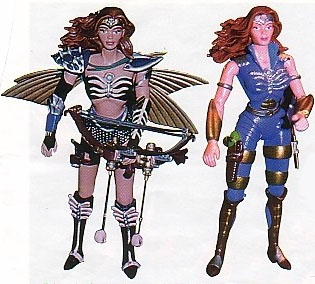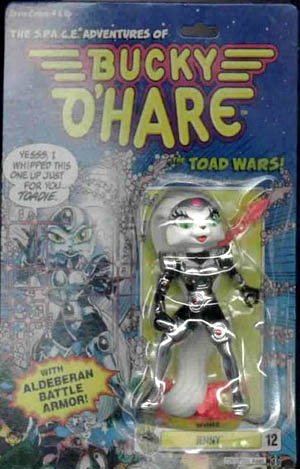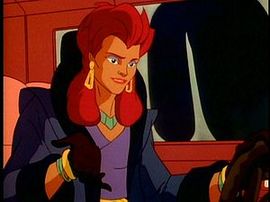The 10 Most Unfairly Toyless Women
From He-Man to Dragon Flyz, the male-dominated toy empires of the past two decades strove to build some fa?ade of sexual equality in their cartoons. Even those shows clearly made for nobody but violent 8-year-old boys inserted prominent female characters just to keep the child psychologists happy. Yet bias reigned when it came to the actual toys tied to those cartoons. Aside from G.I. Joe and a few others, the manly toy lines of the ’80s and ’90s paid little attention to the women of their animated 22-minute commercials. Action figures based on female characters were normally made only after a toy venture was popular enough to get lunchboxes, kid-size tents, and other merchandise that could make up for one feminine toy which, the marketers might assure you, would never sell.
In time-honored playground language, this wasn’t fair. It wasn’t fair to the girls who liked Transformers and Inhumanoids just as much as (or more than) My Little Pony. It wasn’t fair to the boys who weren’t ashamed to admit that the thuggish, lipstick-wearing Crusher was the coolest Go-Bot. It wasn’t fair to the fans who felt a constant void in their lives from not having Lydia figures in their collections of Kenner’s crappy Beetlejuice toys. All of these were crimes against equal rights and childhood materialism, and the following list is going to let the world know it by running through the ten greatest injustices in the world of toyless female characters.
10) Virulina from Visionaries
One of the lesser-known Sunbow attempts at duplicating G.I. Joe’s toy-and-cartoon success, Visionaries is a weirdly bleak saga of one of those post-apocalyptic worlds where armored sorcerers battle each other with holograms. It’s Guy Stuff, to be sure, but the mostly clean-shaven heroes and the mostly bearded villains each have a token woman in their ranks. The Spectral Knights have Galadria, a blond, sensible type whose assigned magical imagery involves dolphins. Slightly more interesting is the scheming, antisocial, disease-commanding Virulina. Though she’s just about the only member of the Darkling Lords who doesn’t have facial hair, Virulina has a bizarre reverse widow’s peak and, for her totem animal, a holographic shark. Keeping with the laws set down by professional wrestling and martial-arts flicks, Virulina spends the show feuding primarily with Galadria, though she can be seen duping some of the stupider male Spectral Knights.
With high production costs and a lineup of similar-looking characters, Visionaries struggled in the crowded ’80s toy market. Galadria and Virulina weren’t invited to join the first wave of action figures; such was standard practice for toy makers circa 1987. The line collapsed before another batch of figures could be rolled out in 1988, but this never-produced round of new heroes and villains didn’t include either woman. Yes, a guy with a beetle hologram got a toy, but not an evildoer who had a friggin’ shark. More on these shark-related inequities will come later.
9) Talyn from Skeleton Warriors
A cartoon and toy line seemingly based on bad heavy-metal album covers, Skeleton Warriors carried the hopes of Playmates executives who needed a Ninja Turtles-caliber hit for the mid-1990s. Set in some medieval-techno world that kids clearly weren’t supposed to think about too much, the cartoon casts a trio of justice-defending royal siblings as the only force capable of resisting Baron Dark and his newly flesh-free warriors, all of whom made impressively detailed toys. The line bombed, proving too scary for very young children, too simplistic in tone for older kids, and too grim for the hordes of Power Rangers fans. Besides, Baron Dark? Seriously?
Playmates also bungled the Skeleton Warriors toys by releasing the monstrous villains first. The less ghoulish heroes were saved for months later, after Skeleton Warriors had burned off whatever interest it might have created. Well, most of the heroes were made, at least. Talyn, the redheaded sister to two quarreling-yet-heroic brothers, was never part of the released line, though Playmates had two different figures designed, one more scantily clad and heavily armed than the other. Talyn may seem a generic heroine from a generic show, yet at least one article out there claims her action figure would have saved Skeleton Warriors. In truth, nothing really saved it; not the PlayStation and Saturn games, not the cartoon, and certainly not one skeletal toy’s cameo in the family film The Indian in the Cupboard.
8) Judge J. B. McBride from Bravestarr
A few things kept Judge McBride from joining the Bravestarr toy lineup, aside from the no-girls-allowed rule that governed many an ’80s cartoon’s first spate of action figures. J.B looks a little too normal next to the rest of the Bravestarr supporting cast, as she isn’t a cyborg horse or a green-skinned alien bartender or a two-foot-tall munchkin with the shrillest voice Charlie Adler could muster. She’s just a frontier magistrate who interprets space-Western laws, grants space-Western divorces, and, with the title character’s assistance, provides this strange little interlude in the Bravestarr movie.
Her contribution to Bravestarr‘s futuristic-cowboy milieu is a gavel, which the show nobly tries to make interesting and toy-friendly. It’s not clear how this would have translated into an action figure accessory, but Mattel was going to try it anyway by putting a J.B. McBride figure in the line’s second wave. Bravestarr failed before that could happen, thus leaving the market for judicial-branch toys pitifully barren.
7) Jenny from Bucky O’Hare
Bucky O’Hare was a toy-minded line right down to the comic’s original character designs, so it’s doubly sad that the green space rabbit and his fellow animal-people revolutionaries didn’t fare too well as action figures. To hear Bucky co-developer and comic artist Neal Adams tell it, Hasbro miscalculated when dividing up the first toys, resulting in store aisles lined with the sneering, wart-covered, and thoroughly unappealing Toad Air Marshall figure instead of Bucky himself. It was the equivalent of young Star Wars fans wandering into Toys “R” Us to find an entire wall of nothing but that tubby Rancor Keeper.
Hasbro also balked at putting out a figure of the show’s female lead, even though it was carded and ready to go. Jenny, a psychic cat-woman who serves as Bucky’s second-in-command (and disturbing, cross-species love interest), is heavily featured in the Bucky O’Hare cartoon and videogames. While the four-armed duck and the one-eyed robot and the completely unnecessary human kid were greenlit for toys, Jenny wasn’t seen as a bankable character. So her toy was moved from the first wave to the second, to be released after all of those Toad Air Marshalls made the Bucky O’Hare brand a certified hit. Guess whether or not that second wave was canceled.
6) Mainframe, Nightshade and others from C.O.P.S.
C.O.P.S., the cartoon and toy property set apart from the live-police-footage show by all-important periods, is occasionally praised for putting out most of its major characters in a short amount of time. Yet it still played by the same rules as other action-figure lines of the 1980s, and the women from the TV show had to wait until the men had cleared a spot on toy shelves. That spot was never clear enough, and so C.O.P.S. fans never saw figures of Mainframe, Mirage, Nightshade, and Ms. Demeanor.
In Hasbro’s defense, the show’s female cast members are tougher to turn into gimmicky toys. The male
characters of C.O.P.S. have ready-made action features, such as Buttons McBoomBoom’s flip-out torso machine guns. By contrast, Mainframe is…well, the resident computer expert. Mirage is an undercover cop who’s barely present in the show’s intro. Neither career lends itself well to battle-action plastic. The villains might fare a little better: Nightshade is a jewel thief with a variety of stealth-aiding devices, and the super-strong Ms. Demeanor’s toy could pull off some destructive feat. What’s more, the C.O.P.S. toy line always hedged its bets by giving every character a gun that used real caps. You could make a decent action figure out of Nightshade’s zipline and amazing spiked mullet, but only a cap-firing, adult-annoying miniature firearm will get it on the wish-lists of children everywhere
—-
5) Scorpa and Shadow Weaver from She-Ra
Mercenary as the whole concept of She-Ra is, it’s hard to deny that He-Man’s twin sister is considerably more daring than the usual girls’ cartoon lead of the 1980s. Capable of the same stiffly animated superhuman feats as He-Man, She-Ra spends a typical episode throwing tanks around and beating back the presumably robotic forces of an industrialized empire. You won’t see that in, say, Lady Lovely Locks. When it came to the toy lines, She-Ra wisely gave part of its cast to the He-Man half of Mattel’s cash cow. She-Ra’s monstrous Horde enemies were sold with Masters of the Universe backing, while the women of the series, good or evil, were marketed as pure She-Ra toys.
This arrangement caught some characters in the middle. One was Scorpia, a Horde follower with chitinous red armor and the claws and tail of a scorpion. She was perhaps too freakish for the She-Ra line, which preferred villains with comb-able hair and cat masks. She was also a low priority for the He-Man camp, where the quota for a pincher-handed, exoskeleton-covered villain was filled by a crayfish-faced man.
The other notable absence in the She-Ra toy ranks was Shadow Weaver, an evil sorceress whose toy would’ve been demanded by kids just so they could see what she really looked liked under that hood (spoiler: according to the She-Ra comics, it’s as disappointing as a Jawa’s real face). Like Scorpia, Shadow Weaver had a toy on the drawing boards, but it likely deviated too much from the standard She-Ra mold. Shadow Weaver still has fans, though, and one of them dedicated an entire ad-filled Angelfire page to the magical Horde flunky. That’s one toy retroactively sold.
4) Tula from Pirates of Dark Water
Tula is yet another cartoon heroine who would have surely received the toy treatment had her series taken off. If The Pirates of Dark Water had survived tight-fisted budgeting and the cries of parents’ groups opposed to any hint of realistic violence, you can bet that Tula would have been immortalized in funny-smelling plastic, carded, and…well, short-packed in comparison to the male characters. This would later make her toy a highly sought-after collectible among the many, many Dark Water fans who exist only in a happy pretend alternate dimension where it rains chocolate.
Tula is a duplicitous adventurer as the Dark Water cartoon begins, but she dispenses with trickery early on and settles into her role of verbally sparring with the relentlessly chauvinistic Ioz and spouting all sorts of fake swear words. She didn’t make the franchise’s first set of toys, as Hasbro preferred to concentrate on male characters like the background space-filler Joat and the red-haired Zoolie, the latter of whom resembles some beer-gutted extra from Disney’s The Little Mermaid. Toy makers commonly thought that female characters didn’t sell in boys’ toy lines, but we’d like to hear someone argue that one-episode fat guys sell better.
3) Pythona from G.I. Joe
Defying the practices of its day, G.I. Joe managed to get nearly all of its female characters into toy stores. Kids could buy Scarlett, Lady Jaye, Jinx, the Baroness, and even Zarana, the pink-haired Dreadnok who inexplicably fell for the Joes’ computer nerd. Hasbro may have set out to do justice to the women of the franchise, though we suspect that it was also easy to make just about any character when four figures cost as much as one good-size Transformer. With that in mind, there’s one curiously neglected G.I. Joe woman: Pythona. Scaly and sporting that bald-but-for-a-ponytail look that’s surely someone’s fetish, Pythona sets off G.I. Joe: The Movie‘s main conflict by breaking into a Cobra base and introducing everyone to Cobra-La, an ancient, never-before-hinted-at civilization that, get this, was really behind Cobra all along.
That logical gap may explain the absence of a Pythona action figure. While the movie was full of Cobra-La gimmicks that were clearly intended as toy material, the new villains inspired only a three-pack of the half-snake Golobulus, the winged Nemesis Enforcer, and a Cobra-La drone soldier. See, no one really liked Cobra-La. Even some of the G.I. Joe cartoon’s writers hated Cobra-La. During the somewhat troubled TV episodes that followed the movie, Cobra-La was practically retconned away, and Hasbro slowly backed off from any toys related to the film. While this cost fans a Pythona figure, it also killed the chances of seeing a toy based on Big Lob, the G.I. Joe team’s self-narrating basketball soldier. The less said about him, the better.
2) Elita One and Her Followers from Transformers
Next to its contemporaries, the 1980s Transformers cartoon was noticeably sexist. While nearly half of G.I. Joe’s TV run featured Lady Jaye somewhere, the first two seasons of Transformers dedicated a single episode to showing a few female Autobots waging a guerilla war on Cybertron. Little was rectified in the Transformers movie and its subsequent third TV season, which introduced Arcee. She was pink, rarely decisive, and seemed to be around just to act maternal toward the show’s most annoying kid character. And her car form looked lame.
Thanks to the undying presence of Transformers in toy and collector markets, Arcee became an action figure several times this deca
de. The same can’t be said for the original lineup of female Autobots: Firestar, Moonracer, Chromia, and their leader (and Optimus Prime’s girlfriend), Elita One. Chromia was kinda-sorta squeaked out as a re-tooled Arcee, but not one of the team became a toy in her original form, even though all of them seemed made for the plastic treatment. Their episode of the TV show goes out of its way to show them all turning into stylish Cybertron cars that would have fit right into the post-movie Transformers toy lines. If you’re going to make cartoons about toys, at least let the kids own those toys.
1) Gloria Baker from M.A.S.K.
To be honest, we’re not lamenting the lack of a Gloria Baker action figure here. We can’t. The racing enthusiast and her jaw-droppingly spectacular mullet (which eclipses even the above-mentioned Nightshade’s hairstyle) eventually became a toy in M.A.S.K.’s Split Seconds line, a late-stage attempt to keep the brand relevant. Yet M.A.S.K. was never really about the human characters; it was about the motorcycle that turned into a helicopter or the helicopter that turned into a jet or the jeep that spat out a hydrofoil. We’d have been just as happy if Kenner had made the vehicles without drivers, but the FCC would never let you fill 75 syndicated TV episodes with unmanned cars and trucks playing out Stephen King’s Maximum Overdrive Jr. We don’t doubt that kids liked Gloria, but we suspect that a lot of viewers just wanted the Shark, her combination Porsche 928 and submarine. In fact, screw the submarine part. A Porsche on its own could sell toys when it was animated well enough.
Yet there would be no Shark toy. It showed up in catalogs, but somewhere along the line Kenner either failed to get the rights or decided it wasn’t worth the trouble. This made the original Gloria figure and her Porsche the most famous toy-deficient woman (and car) of 1980s toy lines. There’s always someone who claims that a neighbor’s brother had it, stashed in with his Zelda III NES game and the comic where Batman totally kills Spider-Man and Superman. Or there’s someone who puts together an actual replica of the Shark with a box and everything.
Kenner tried to make it up to M.A.S.K. fans by giving the Split Seconds Gloria figure a Lamborghini Countach that turned into a helicopter. It was a shrewd maneuver, as the Lamborghini was among the few sports cars that ranked higher than the Porsche in the minds of Reaganaut children. But it wasn’t the Shark, and it didn’t count.

